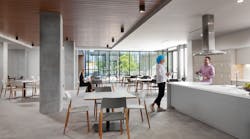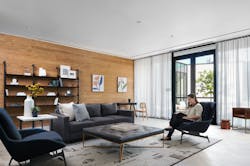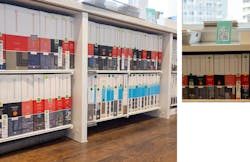Perkins&Will's Tori Wickard Talks Total Transparency
In my eighth year as an architect, I lost my mother to breast cancer. It was hard for me to accept that her non-genetic form of breast cancer occurred by happenstance, and I believed there must be some environmental factors that contributed. This was one of the most difficult times in my life, but I felt motivated to use my grief for positive change. What if environmental factors were things that I, as an architect, could actually control?
Not long after, a colleague approached me cautiously and explained we’d been hired to work on several projects for the American Cancer Society Hope Lodge—free hotels for cancer patients undergoing treatment. I recall him saying, “It’s okay to say no if it’s too soon,” but I jumped at the opportunity to lead these projects. I wasn’t yet well-versed in healthy building materials, but I recognized a great resource in my Perkins&Will colleague Mary Dickinson, who at the time led the Materials Matter series for AIA Dallas. This would be a great opportunity to explore potential harms in the built environment and push for much-needed changes.
This was 2014, and just the year before, LEED v4 had been released with its expanded focus on the impact of materials and resources on human health and the environment. I recalled beta-testing LEED v4, reading the transparency requirements and thinking, “They want us to ask for what?! This will never happen!” Rather than be deterred, though, a group of major architecture firms, including Perkins&Will, conferred and wrote public letters requesting greater transparency from manufacturers about the content of their products.
For the Hope Lodge projects, which involved designing spaces for an especially vulnerable set of occupants, I needed this transparency more than ever. Where is it more important to reduce carcinogens than in a residence for cancer patients? We needed to understand the material makeup of all building products involved to give the patients—retiring to these spaces after exhausting days of treatment—the best possible chance to heal.Perkins&Will and the American Cancer Society co-authored a Letter of Commitment outlining a central tenant: reducing and eliminating substances of concern linked to negative impacts on human health, specifically carcinogens and immunotoxins. The letter urged suppliers and manufacturers to provide a written commitment to eliminate “Perkins&Will Precautionary List” substances from their products and to disclose material ingredients in full, to 100ppm. For reference, Material Safety Data Sheets report substances at 10,000ppm, a much higher concentration at which highly hazardous materials, or those that pose a high risk to human health, can be missed entirely.
This unified effort in support of a non-toxic and transparent materials market was met with some reluctance. Sadly, few manufacturers responded proactively. Some passed information along for products that had some form of transparency documentation already available, such as Health Product Declarations (HPDs) or Declare Labels. Manufacturers, though, often don’t disclose all substances due to proprietary ingredients or reporting thresholds that don’t paint a full picture. Concerns like per- and polyfluoroalkyl substances (PFAS), often used as stain repellents, are harmful in very small quantities and do not show up at a reporting threshold that is not granular.
Overwhelmingly, to find optimized building products, we had to really work hard. A large percentage of the team’s time was spent educating.
Most of the time, when pressed, local product reps admitted they didn’t quite understand the ask or its importance. Often people believe the EPA protects us from everything that can be considered hazardous. They are not aware that the Toxic Substances Control Act (TSCA) exists or that it does not require companies to conduct toxicity testing before a chemical is introduced into the market. Manufacturers are also allowed to claim Confidential Business Information.
In our work investigating materials for Hope Lodge, we prioritized high-contact and high-volume products like flooring and paint. We used a variety of platforms to assess over 80 products, including our own database containing products that have met the firm’s library protocol.
I remember teaching one rep about a concerning substance in the very product he was representing and watching a deer-in-the-headlights look form on his face. His family lived downstream from the manufacturing facility for that particular chemical, and they’d been experiencing major health issues. He looked like he was going to be sick.
Everyone on the team felt significant emotional investment in the Hope Lodge projects, and this challenging process of vetting and education came from a place of real passion. We truly believed our design decisions could help ease the strain during cancer treatment and improve a patient’s quality of life.
These projects were pilots that helped us significantly advance our firm’s material health practices and, as a result, develop a new material health strategy and process. This includes a Wellness and Sustainable Design Verification Form that helps contractors ensure different products meet project goals, a firmwide Material Tracking Worksheet used for internal sustainability reporting and project optimization, a Letter of Commitment that can be used to secure buy-in from clients or manufacturers, and a Library Protocol that establishes material transparency as a baseline.In my work now, I try to help others see that this passion and dedication to transparency is something all projects and all building occupants deserve. We spend a huge percentage of our lives indoors, and exposure to harmful chemicals can account for 80-85% of disease risk.* Asking for transparency is as necessary as following up with action and education.
Fortunately, the transparency and material health movement has greatly advanced since I began working on the Hope Lodge projects. Today, there are many more materials with published transparency documentation and easy-to-use databases that allow quick access to material information. I find conversations with reps to be more enlightened, and public awareness around toxic substances is at a high. I have great hope that the materials market will continue to evolve in a positive direction and I look forward to continuing to be part of the movement.
*Jones et al 2012 Annu Rev Nutr 32:183-202; Miller and Jones 2014 Toxicol Sci 137:1-2


